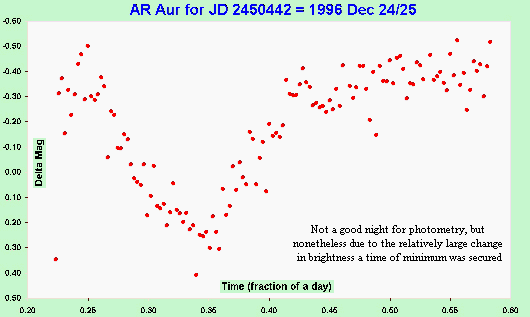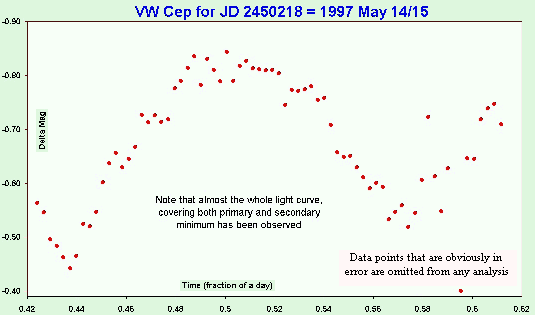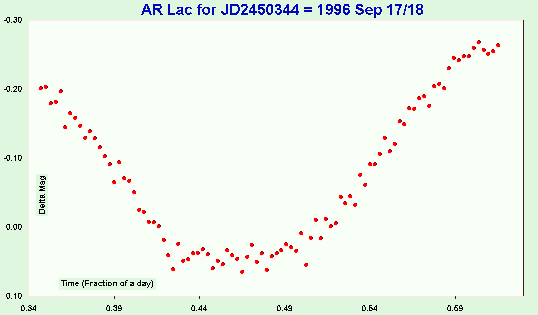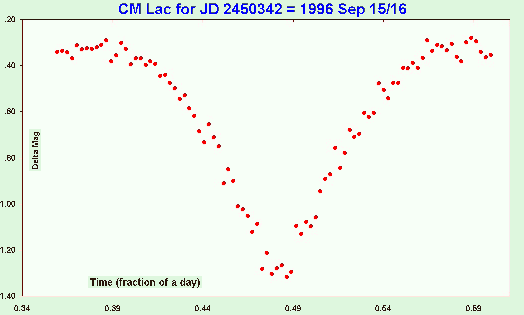
The telescope performed without incident during 1996, but of course, the weather, oh the weather! Indeed, until the Autumn, we recorded the fewest number of observations ever. Apart from a short spell of fine weather in February, only one worthwhile observation was made until the onset of Autumn, when a more normal weather pattern developed.
A summary of the observations is reported in Table 1 below.
It must be emphasised that the results summary presented here, as in previous years, does not list all the occasions when the APT was set up, but for some reason, such as cloud (usually) or mechanical breakdown, etc., no results were obtained.
In Table 1, under "Comments", any reference to "no result" means that, although a number of observations were obtained, apparently the ephemeris is in error, and no eclipse was seen. Although our prediction programme is constantly updated, some of the stars have not been observed for a number of years, or at least, no observations have been reported that we are aware of, and so we are relying on an old ephemeris. With some stars this is just not adequate, as in the case of V1898 Cyg, where we have been trying to catch at another minimum for some years now! (The minimum recorded on 2449332 was not a particularly good one).
This might also be a good moment to explain a little of the procedure that must be adopted in order to report APT observations.
It must be explained immediately that all the telescope software was written for use on a BBC computer which means that it is not immediately readable on a modern PC. Therefore, after the initial reduction and analysis of the observations on the trusty Beeb, the results must be converted into a plain text format for transporting to the PC. In this respect it was necessary for fellow Crayford member, John Howarth, to write a programme and supply a suitable cable so that the Beeb and the PC could be connected together and the data transmitted across. Once that has been done, the data can be manipulated using one of the standard software packages available.
In some instances, for example the data for Chris Lloyd, it is has become necessary to supply more than just the reduced data and John Howarth again came to the rescue by writing a suitable programme to transfer all the Beeb output onto a PC.
In addition, sometimes it is useful to play around with the data analyis programme on the Beeb to extract the last bit of useful information, especially where EBs are concerned.
All this represents quite a time consuming exercise, especially if there are many results to analyse.




| No | Double Date 1996 | JD 2450.. | Star Name |
Star Type | No. of Obs. | Filter | Comments |
|---|---|---|---|---|---|---|---|
| 1 | Feb 8/9 | 122 | NSV 1663 | Delta Scuti | 72 | V | For Chris Lloyd |
| 2 | Feb 16/17 | 130 | " | " | 38 | V | " |
| 3 | Feb 27/28 | 141 | " | " | 56 | V | " |
| 4 | Apr 17/18 | 191 | AW UMa | EW | 50 | V | No result |
| 5 | May 14/15 | 218 | VW Cep | EW | 71 | V | Mins I & II |
| 6 | Jun 4/5 | 239 | V1898 Cyg | ? | 67 | V | No result |
| 7 | Sep 13/14 | 340 | SW Lac | EW | 95 | V | Min I |
| 8 | Sep 15/16 | 342 | CM Lac | EA | 90 | V | Min I |
| 9 | Sep 16/17 | 343 | V836 Cyg | EB | 119 | V | Min I |
| 10 | Sep 17/18 | 344 | AR Lac | EA | 94 | V | Min II |
| 11 | Oct 2/3 | 359 | V477 Cyg | EA | 47 | V | No result |
| 12 | Oct 5/6 | 362 | XZ Cep | EB | 48 | V | No result |
| 13 | Oct 15/16 | 372 | DM Per | EA | 80 | V | No result |
| 14 | Oct 16/17 | 373 | GH Peg | EA | 21 | V | No result |
| 15 | Oct 22/23 | 379 | AO Cas | EB | 54 | V | No result |
| 16 | Nov 14/15 | 402 | X Per | Be | 6 | V | For Paul Roche |
| 17 | Nov 14/15 | 402 | X Per | Be | 3 | B | " |
| 18 | Nov 18/19 | 406 | AH Cep | EB | 45 | V | No result |
| 19 | Nov 23/24 | 411 | NSV 1663 | Delta Scuti | 52 | V | For Chris Lloyd |
| 20 | Nov 29/30 | 417 | " | " | 61 | V | " |
| 21 | Dec 4/5 | 422 | " | " | 136 | V | " |
| 22 | Dec 5/6 | 423 | " | " | 93 | V | " |
| 23 | Dec 24/25 | 442 | AR Aur | EA | 130 | V | Min I |
Notes:-
Chris Lloyd is a professional astronomer at Rutherford Appleton Laboratory.
Paul Roche is a professional astronomer at Sussex University.
No result means an eclipse was not seen indicating the ephemeris is in error.
For further information on the APT or PEP contact R D Pickard